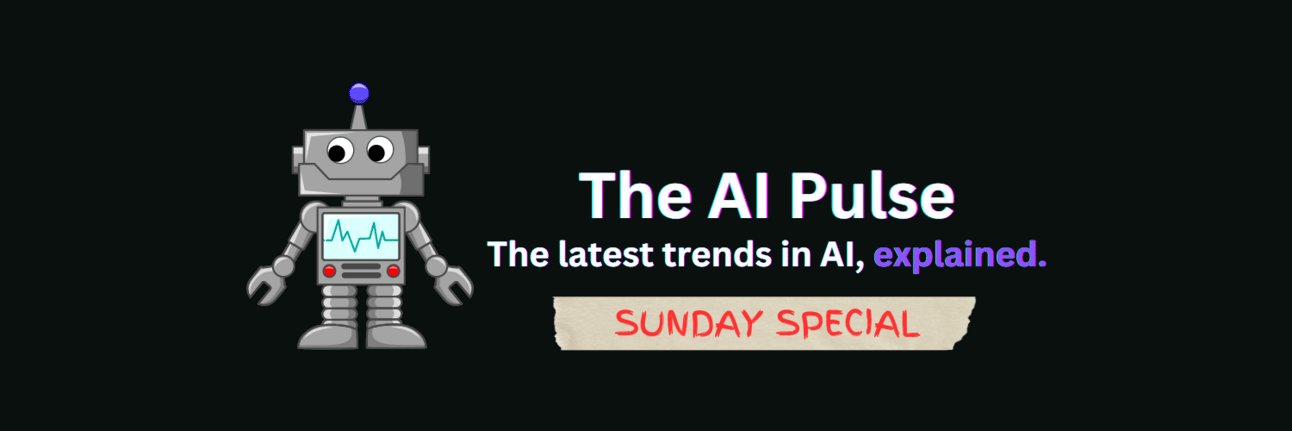
Welcome back AI prodigies!
In today’s Sunday Special:
📊Intelligence, Unearthed
🦾Technology and Thinking
🤖Systems Supersede Individuals
🔑Key Takeaway
Read Time: 8 minutes
🎓Key Terms
Cattell-Horn-Carroll (CHC) Theory: defines human intelligence through cognitive skills, including comprehension knowledge, fluid reasoning, auditory processing, long-term retrieval, short-term memory, processing speed, and visual-spatial thinking.
Artificial-General Intelligence (AGI): AI models that can perform tasks as well as humans and exhibit human traits such as critical reasoning, intuition, consciousness, sentience, and emotional awareness.
🩺 PULSE CHECK
Are we becoming dumber?
📊INTELLIGENCE, UNEARTHED
“Think of how stupid the average person is, and realize half of them are stupider than that.” In 1990, American comedian George Carlin delivered a zinger. At the time, the public wasn’t that dumb. Before the information revolution, most Americans had to think for themselves. To learn, people read; watching TV or listening to the radio wasn’t as captivating as today’s videos and podcasts. To navigate, people planned trips step-by-step and memorized waypoints. To recreate, people socialized and exercised. Over the last 30 years, vocabulary skills, intelligence, and active leisure have declined significantly. If this trend continues, we risk undermining the very foundations of our society, doing far more harm than AI-induced automation or AGI could ever do.
In a 1984 study, intelligence researcher James Flynn noticed that intelligence test scores had steadily increased since the early 1930s, faster than evolution could explain. In the 21st century, evidence now indicates a reverse Flynn effect. First, how is intelligence measured? Researchers rely on the CHC Theory, which excludes emotional intelligence, to differentiate between fluid and crystallized intelligence.
Fluid Intelligence: an individual’s ability to abstractly reason and solve problems.
Crystallized Intelligence: the knowledge that is accumulated and learned over time.
A landmark study from Northwestern University examined survey responses from 394,378 Americans between 2006 and 2018 to examine if fluid intelligence scores changed within the U.S. in those 13 years. Ability scores of verbal reasoning (e.g., logic and vocabulary), matrix reasoning (e.g., visual problem solving and analogies), and letter and number series (e.g., computational and mathematical) dropped during the study period.
Composite ability scores (i.e., single scores derived from multiple pieces of information) were also lower for more recent samples. The differences in scores were present regardless of age, education, or gender.
The study also found that scores of 3D rotation (i.e., the ability to rotate mental representations of objects in your mind) generally increased from 2011 to 2018.
Despite these concerning findings, many remain skeptical about the real-world relevance of IQ tests. However, even if they merely measure our abstract problem-solving ability, the reasons behind that decline are numerous. One theory is the diminished motivation of test-takers, but the fall in IQ scores isn’t consistent across the board, as scores are rising in one crucial domain—shape rotation puzzles. One of the study’s authors suggests that the emphasis on Science, Technology, Engineering, and Math (STEM) subjects in educational environments might be to blame for devaluing the purely abstract, but science and math are built on understanding abstract ideas. Perhaps another 21st-century megatrend—the information revolution—is partly to blame.
🦾TECHNOLOGY AND THINKING
In the bite-sized content and viral media age, too many of us, including older adults, need more focus and patience to consume lengthy, complex texts. From 2004 to 2015, average adult attention spans on screens shrunk from 150 to a mere 47 seconds. Concurrently, recreational screen time skyrocketed from 20 to nearly 29 hours per week. While technology has enabled the wide dissemination of information, it has also fragmented our thinking. As legacy media outlets and social media creators compete for attention, we’re overwhelmed by sound bites and sensationalism.
Without reading comprehension, we cannot thoughtfully process information and make reasoned decisions. We lose the ability to thoroughly analyze issues, think critically, understand different perspectives, spot logical fallacies, and weigh evidence. Our opinions get shaped by alarmist rhetoric and confirmation bias rather than facts. We consume information, but we don’t truly digest it. This passive binge erodes the foundation of a functioning society—an educated populace.
In the wake of OpenAI’s ChatGPT, some argue that AI poses the greatest existential threat of our time. Advanced algorithms can automate jobs, enable manipulation through deepfakes, and weaponize disinformation. However, AI systems are still man-made. Their capabilities are limited by what programmers develop. While potentially dangerous, current AI lacks sentience—the ability to think and feel.
In contrast, the death of critical reading harms the conscious minds of billions—minds that design, build, regulate, and use technology for good or ill, minds that make ethical judgments with global consequences. Losing the ability to comprehend the world around us and make sense of complex ideas is an existential crisis and a generational challenge.
🤖SYSTEMS SUPERSEDE INDIVIDUALS
Each of us can make an effort to read diversely, reflect deeply, and verify claims before spreading them. We can also consciously apply critical reading skills to modern media instead of reacting reflexively. However, individual choices and actions are inadequate.
The drop in reading comprehension is a complex phenomenon. Simplistic explanations like “technology ruined our attention span” fail to capture the entire picture. Blaming Gen Z or non-college-educated individuals ignores the mass vulnerabilities to misinformation demonstrated by older, college-educated users who have flocked to movements. The modern digital media environment trains every brain, regardless of education level or “intelligence,” in ways antithetical to immersive, contemplative reading. The endless stream of stimuli fragments our concentration into shards as our attention flits briefly from one post to another without diving deeper into any topic. The design of apps and sites deliberately exploits our psychological vulnerabilities. Pull-to-refresh and auto-play trick our brains with endless novelty, and notifications interrupt our thoughts with external prompts.
Meanwhile, lengthy texts full of substantive information struggle to compete. Their interfaces don’t addict readers; they illuminate discourse. The static, mundane blog of the early internet relies on something other than recent developments like high-bandwidth video, AI-generated visual content, or algorithmic entrapment. Their creators are more concerned with truth than clicks; if they provide value, the money will come. But these oases of deep reading feel increasingly foreign to modern minds accustomed to constant sensory stimulation. Their depth requires patience and analytical effort that feels unnatural after years of skimming and scrolling.
But it would be unfair to blame technology alone. The economics of the news industry have evolved to prioritize profits over public service. As traditional revenue models collapsed, many outlets pursued clicks and shares over quality journalism, as the 24-hour news cycle promotes speed over accuracy. These institutional pressures make it harder for nuanced, investigated stories to thrive. Separately, K-12 schools face immense pressure to teach standardized tests. Educators drill math and science facts over critical thinking skills. Expository writing is emphasized less than formulaic essays. Students often get rewarded for rote memorization and inputting numbers into formulas more than original analysis. This system discourages the intellectual curiosity and patience needed for deep reading.
Beyond that, poverty and inequality play significant roles. Reading proficiency strongly correlates with socioeconomic status. Those needing help to meet basic needs have less time and energy for books. Low-income areas suffer from underfunded schools with overcrowded classrooms and limited resources. These environmental disadvantages become roadblocks to literacy. This issue intertwines many complex societal threads—technology, media, education, and economics. There are no singular causes or solutions, only dire implications.
🔑KEY TAKEAWAY
A society that cannot patiently read long-form texts struggles to make sense of the world in ways that enable wise judgment, empathy across differences, effective policies, political progress, and scientific reason to prevail. AI adoption, amid a backdrop of extreme intellectual inequality, paints a bleak future. On the other hand, AI advancements provide the opportunity to democratize access to tailored learning, allowing lower-income schools to improve education levels.
📒FINAL NOTE
If you found this useful, follow us on Twitter or provide honest feedback below. It helps us improve our content.
How was today’s newsletter?
❤️TAIP Review of the Week
“I really enjoy reading your Sunday Specials with my morning coffee!”
REFER & EARN
🎉Your Friends Learn, You Earn!
{{rp_personalized_text}}
Refer 9 friends to enter 🎰May’s $200 Gift Card Giveaway.
Copy and paste this link to others: {{rp_refer_url}}
